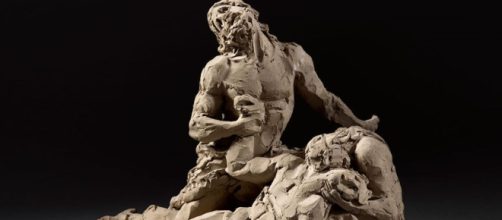Sketches are usually notes jotted down for an idea that later becomes a painting or sculpture. This is a story about preliminary work that ends up unintentionally superior to the final product.
"Sketching in Clay," the National Gallery's new show of Antonio Canova's dry runs for his marble sculptures, can put you in mind of Degas's wax figures made in preparation for his painting.
Written in stone
Degas' waxworks were never meant as run-ups to the bronze figures regularly shown in museums. They were fabricated after he died. For that reason, Canova's clay sketches, still bearing his fingerprints, outclass any show of Degas' so-called bronzes.
The National Gallery, then, can rightly claim that Canova's clay works "led to the creation of some of the most iconic works in the history of sculpture." (Iconic, yes; incomparable, no. His sketches are more commanding. More about that in a moment).
Thinking about Canova's clay figures may also remind you of Rodin, who is credited for innovating emotive figures with rough-hewn surfaces. One look at Canova's raw-looking clay work made some eight decades earlier, tells you he did it first.
Roughing it
Of course, the difference between these two sculptors is in their finished products. When it came to turning his clay sketches into marble statuary, Canova smoothed out all the emotive textures to slick and shiny surfaces.
In contrast, Rodin kept the unevenness in his final works to heighten their emotional states.
Before sculptors changed their approach from representational to abstract, it was Rodin who made the big leap from the time-worn Greco-Roman way to the rough and raw look.
Although Canova's clay figures make plain that he initiated the escape from the Greco-Roman tradition, he reverted to type of the ancients in his marble figures, idealizing them to a silken-smooth fault.
Slick and sappy
Canova's marble statue "Venus and Adonis," neo-classical down to its glossy put-on-a-pedestal finish, comes across as so rhapsodic that it comes off sappy like the cover art of paperback romance novels sold at airports.
But Canova's clay sculpture of "Adam and Eve Mourning the Dead Abel," with its broken surfaces looking like he's about to splinter into pieces, can break your heart.
The rawness of these clay figures is comparable to the broken surfaces of Impressionist painting in that they achieve the same result – vividness.
Clearly, Canova felt freer expressing raw emotion with clay than with marble. His image of the grief-stricken Adam reminds me of the pathos that Rodin conveyed in his sculpture "Kneeling Figure."
That image of a man on his knees throwing his arms up to the heavens, one fist balled, the other open in a beseeching gesture, is the picture of Canova's Adam torn inside over his son's death.
In the 2001 book "Art Conversations with Paul Gsell," Rodin described "Kneeling Figure" like this: "All his being is drawn out with anguish. His body is thrown backwards.
The breast heaves, the throat is tense with despair, and the hands are thrown out towards some mysterious being to which they long to cling."
Can you think of a better description of Canova's "Adam and Eve Mourning the Dead Abel"?


